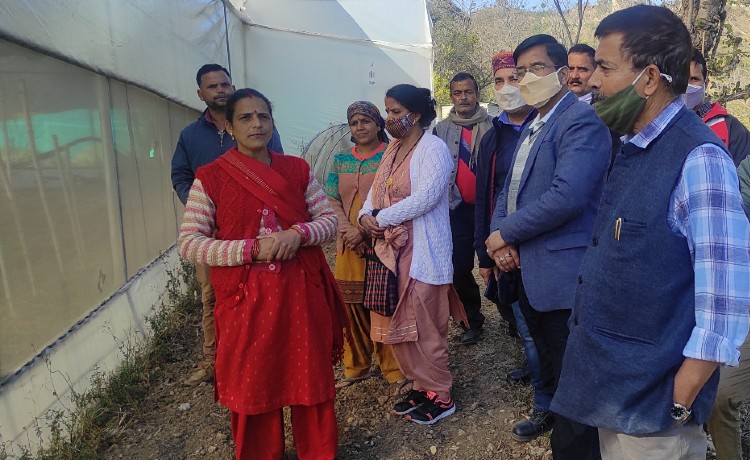When it comes
to key stakeholders in agriculture and rural development in India, there is no
bigger player than NABARD who, with a 7, 50,000 crore balance sheet, are a
primary investor in the revitalisation of rural India. It makes sense then, for
Ambuja Cement Foundation (ACF) to work closely with them – after all, both
organisations are working towards the same vision – rural prosperity!
Discussing
the extensive ACF & NABARD partnership which has grown from just 1
Watershed project in Daseran to 35 Rural Development Projects across sectors in
2022, Thrive caught up with Dr Sudhanshu K K Mishra - the Chief General Manager
for Himachal Pradesh Regional Office (NABARD) who has spent over 35 years with
NABARD in various capacities. In a candid interview, we talk all things rural
development, watershed and synergies between the two giants.
What is the
secret to success in watershed development?
When
we work on a watershed, it is usually treatment of an area of 1000 ha area from
ridge to valley, with a view to conserve rain water which includes structures
to prevent runoff and agronomic practices of planting grasses shrubs, bushes,
trees which prevents water runoff and promotes ground water recharge and more cultivatable
area including multiple crop farm systems. Watershed is community based,
community paced and therefore must be community managed – this is of primary
importance. As an expert coming from the
outside, I may know something, but I must first consult the community on grass
root level circumstances, satisfy the community on components of the watershed and
the community must be strongly motivated to implement and maintain the project after
we are gone. We therefore must have a very
clear exit strategy in mind at the very start.
Once while working on a watershed project in Baharaich District in Uttar pradesh, we were working on a field bund construction, and one farmer insisted on cutting the field bunds constructed under the project. I went and interacted with him and he said, ‘I am losing 2 quintals of wheat because of the area lost in the field bund.’ I explained that in the long term it will give better moisture and soil conservation, but his argument was so strong that it forced many farmers to run away. If you only talk of long term benefits to farmers they might not understand, due to the urgency of their immediate priorities. So to address the short term community expectations, I introduced lemongrass and took farmers to see first-hand, essential oils extraction at Kannauj which was around 300 Km away from the project area . When they realised lemongrass oil was being made for Rs. 2000 per kilo, they asked ‘How do we do it?’ and jumped on board. This ensured that field bund is not destroyed and they had a new source of Income besides giving long term soil and moisture conservation benefits. It also gave permanent green cover to our watershed area.
Many projects have gone haywire for similar reasons. We have taught water conservation in places like Maharashtra, but as soon as water was available, farmers quickly moved into water guzzling crops like bananas with the result being a zero sum game. The people are central to success in watershed, and it is one of the primary reasons we partner with Ambuja Cement Foundation. When we partner with ACF on watershed, we end up with creation of ecosystem s where farmers learn to synchronise with both nature and the market. This is of primary importance.

What are some of the other reasons you think the ACF NABARD partnership is so successful?
When
we choose a partner, first we want to see whether our mandates are the same –
that is very, very important. Then we look at the outcomes – what are going to
be the outcomes of the project and how will they benefit the people. We very
critically assess the delivery capacity of the NGO – whether they have the
wherewithal to actually execute and implement what they say they are going
to. In these three areas, ACF is aligned
with us and our priorities.
The advantage
of working with ACF is that the institution has worked very long in this field
and built core competency in community participation, implementation of
watershed structures, agronomic practices and encouraging communities for joint
management of common grasslands, shifting to sustainable farming systems and
encouraging landless farmers to take up activities like raising nurseries and
beekeeping. In the end entire community should benefit.
One
more thing, I work on what Schumpeter, German economist said - unless and until
you have a critical minimal speed, a plane will never take off. For an
organisation as big as NABARD, if we have 1 or 2 watersheds in Himachal Pradesh
it is not of much use in terms of major economic or social impact. Our interventions must be in sufficiently
large number so that the benefits are visible to the community and it spreads
on its own. Unless we get volume and scale,
we cannot make an impact. ACF, by
working on sufficiently large number of SHGs, community-based organisations and
FPOs of watershed farmers, achieves our mandated goals.
We also
need players who have commitment, experience and deep pockets to stay in the
rural communities for long time. Sadly,
a lot of players are ‘fly-by-night operators ’ which come to rural projects for
short term gains like government subsidies and do not have patience to work on
winning community trust and confidence.
We
are also happy to have diversity in projects in particular communities. We are very happy to keep going back to
communities from time to time, because working with the community is something
you cannot get results in the short term and we can also concurrently evaluate
whether our initiatives are accepted by the community. We need to invest in a variety of ‘on farm’
and ‘off farm’ projects to see major results.
If you get it right and people are ready to take our advice on how to
use the land and how to work with nature – we can earn rural communities respect
for life! And our projects spread without any further handholding and fund
infusion. I feel ACF has been successful
in earning that respect from people.
There is so much latent potential in Rural India, what is
needed to unlock that?
Many
things come to mind. For every 8 acres of land in Himachal Pradesh, 1 acre is
fallow land. Hill agriculture is very
different from agriculture in plain areas and extremely difficult. Sadly,
people are moving away from agriculture because it is rainfed and with small
plots it is difficult to generate a return.
Climate change is also forcing people to move – apple cultivation is now
moving to higher altitudes; farmers are moving from cash crops like vegetable
cultivation to tropical horticulture like guava and lemon as they have better
survival prospects.
Therefore,
there is a need to promote natural farming techniques and other activities in
allied agriculture to help make farming more profitable. If we can grow fodder on marginal lands, it can
really be a game changer, with more farmer families, especially rural women,
adopting animal husbandry. Watershed in Himachal Pradesh is based on community
grasslands – every family can have 2 cows which effectively means the household
has nutritional food for children, supplementary income for the family, and
fertiliser. There is a need for more
diversification like this, adding animal husbandry to normal agriculture, or
shifting into horticulture-based farming systems also. We need to create and generate an ecosystem
based on natural systems for it all to be sustainable. Agri extension work is
the lifeline of agriculture and we need more professionals in this area to
encourage farmers to work in synergy with nature.
We
also need to move more into value addition.
Whilst conducting a training programme in Kabul, Afghanistan, I was
offered a piece of dried watermelon one day.
We have not been able to perfect the drying of apples and other fruits
grown in Himachal Pradesh. Similarly,
people from Uzbekistan and Tajakistan are supplying us with walnuts in 2-piece,
4 piece and single piece as they have better machinery to crack the nut. We have to find better ways and technology to
value add and give shelf life to our produce and to be able to store it at the
ground level – this will add a lot of value, and then we will see people coming
back to agriculture.
Where is NABARD going as an organisation over the next 5
years?
1. Our forte is the handholding of rural financial institutions and continuing to make them strong.
2. Similarly, we place huge focus on strengthening communities and our community partners are important to us in achieving these goals.
3. If we want to improve agriculture, we have to remove the layers of people from agriculture and provide employment opportunities outside agriculture. In the 60’s and 70’s we have invested in technologies to grow agricultural productivity which unfortunately make agriculture capital intensive. This is making small holding hill agriculture unattractive and resulting in large scale migration from villages to cities for work. In the next decade we must focus on investing in agro processing and agro value chains in a major way.
4. Community based organisations must be strengthened. We want to help Farmer Producer Organisations take a major role in the agro processing and rural economic value chain, cut out middlemen, and deliver profits direct to farmers. This would also boost rural industries in value addition of farm produce and also traditional industries in Handloom and Handicraft. For example, when apples are transported to Delhi, someone in Delhi decides the price. 40% of the apples are slightly inferior in size and colour, but go for prices as low as Rs. 5-10 per kg. but could be used for pulp or juice if only farmers or community-based organisation of farmers like FPOs have access to a small processing plant at the ground level. This would mean they can hold the crop for some time, value add it and work on long term marketing associations.
5. Community empowerment and specifically empowerment of women through Self Help Groups and Joint Liability Groups and encouraging them to take up their rightful role in rural agri processing value chains.
6. Helping State Governments in the creation of rural infrastructure like irrigation, cold storage chains and grading infrastructure.
7. 7. Mainstreaming of formal bank credit to community based farmer organisations which would enable them to increase price reliability for their farmer members.
In
short it means - गाँव बढ़े तो देश बढ़े
We add - महिलाए बढ़े तो गाँव बढ़े








0 Comment